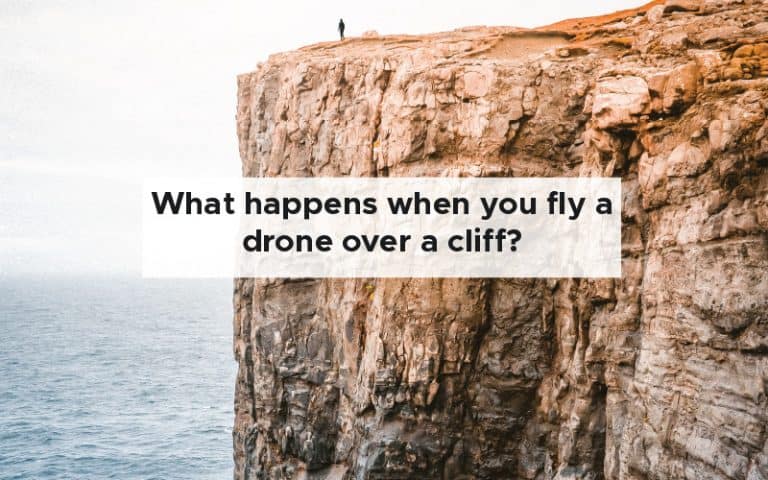I have flown my drone over a cliff loads of times. It is something that I really enjoy doing – being close to the ocean – and cliffs and the contrast between the ocean and the earth is a fantastic place for capturing some incredible drone photos and videos. In this article, we are going to go over exactly what happens when you fly your drone over a cliff and the sorts of hazards that you should look for as well as some shop ideas for making the most of your drone flight over cliffs.
As you fly over a cliff the drone will maintain its height relative to the ground level it recorded at takeoff. It will continue in a straight line over the cliff. If you descend below the height recorded at takeoff your drone will show a negative altitude – this does not put the drone at risk.
When you are flying over cliff the drone can fly at a constant altitude unless you have terrain follow selected. This is available on some DJI drones and only available in active tracking mode. This makes it unlikely that this mode will be selected as it will not be following you off a cliff… Hopefully.
Instead, the drone simply holds its altitude throughout the entire flight until you adjust the altitude using the left joystick.
Initial ground level reading
When you first take off from your landing pad or the ground the drone logs the altitude as the ground level (GL) for the rest of the flight.
This means, if you are flying over a cliff and you descend below the ground level recorded by your drone you will record a negative altitude. Depending on the height of the cliff it could be up to many hundreds of meters if you decide to explore the area at the base of the cliff.
You have to make sure that if you are descending much below the height that you took off at that you are Conservative with your flight time and battery remaining.
It takes a lot of energy for a drone to climb at its maximum rate and some of the algorithms used to predict how much battery you have remaining and when you should return to home do not take into account the extra effort required to fly back up to the takeoff height.
There are plenty of other hazards when flying over a cliff due to its geographical and geological make-up as well as the fact that cliff faces are typically full of wildlife such as nesting birds.
Hazards when flying over a cliff
Flying your drone over a cliff presents some of the more real hazards to your flight than other types of drone missions such as flying in the fields or taking photographs of city based landmarks and features.
Here are some of the most dangerous aspects of flying over a cliff which you should take into account whenever you are considering flying your drone.
Weather
The weather is something that a lot of drone pilots take into account for every flight. However, when you are flying near a cliff face and the ocean the weather can change much quicker than in other parts of the country.
Quite often, I will simply check the local weather forecasts and pay particular attention to the wind gusts and make sure that they are no higher than two thirds of my drone’s maximum horizontal speed.
However, if I am flying near a cliff face or out over the ocean – which can be particularly dangerous – I will pay more attention to the weather and use an app such as UAV Forecast for DJI Quadcopter & UAV Drone Pilots which will tell me all of the important information in a simple and easy to use dashboard.
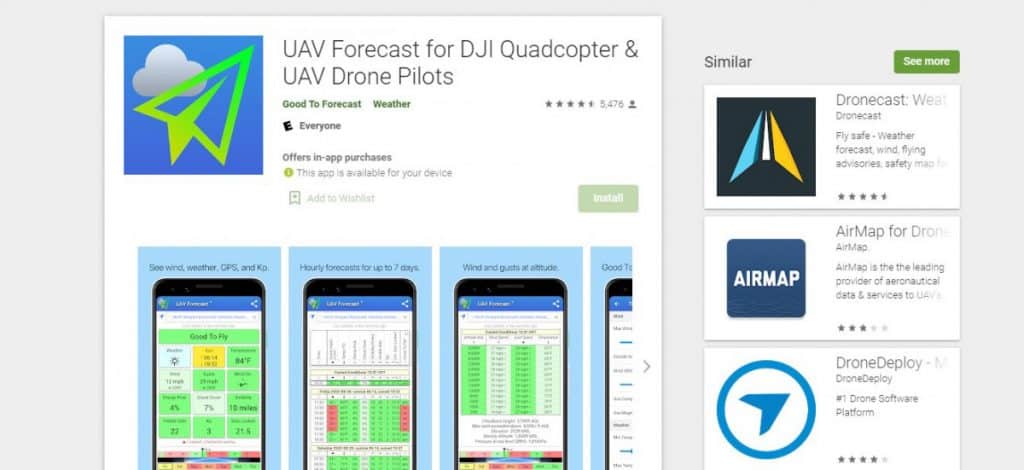
As a simple rule of thumb do not fly your drone in gusts of more than two thirds of your drones maximum horizontal speed and if you are flying near a cliff you need to be particularly wary of updraughts as the drone is not able to compensate for updraughts because of its low vertical speed.
Updrafts
Due to the geographical nature of cliffs they can cause significant updraughts when the wind is coming from the ocean, hitting the cliffs, and being driven up the edge of the rock face.
It is likely that you cannot feel the updraught when you’re stood on the top of the cliff, so it may come as a bit of a surprise as you are flying your drone out and over the cliff.
This is seen as a significant bumpiness in the first person view of the drone and if you have visual line of sight (which you should have most of the time) you will see the drone buffer vertically against the wind.
If you are regularly flying over cliffs that are particularly prone to significant updraughts you should consider getting a drone with a high vertical speed. This, ultimately, comes down to the power of the brushless motors and weight of the drone.
Vertical vs horizontal speed
A drone can reach very high horizontal speeds. For example, the DJI Phantom 4 pro V2 .0 can reach a max speed of up to 72 km/h which is 45 mph in sport mode whilst its maximum ascent speed is 6 m/s and its maximum dissent speed is 4 m/s.
Example vertical versus horizontal speeds
Here are some vertical versus horizontal speeds of some of the most popular drones on the market. You will see that the vertical speeds are significantly lower than the vertical speeds.
| Drone | Horizontal speed mph | Vertical speed m/s |
| Phantom 4 pro the 2.0 | 45 | 5 |
| Autel Evo 2 | 45 | 8 |
| Mavic air 2S | 43 | 6 |
| Mavic Mini 2 | 36 | 5 |
This means that any particularly strong updraught can quickly overwhelm the motors and cause it to lose stability.
Moving away from the edge of the cliff is the only way to overcome the updraught. In my experience it seems to be that after about 5 m of distance from the face of the cliff the drone is able to stabilise again and you can continue your mission. You just have to make sure that the area by the cliff face is minimized.
Wildlife
While you are flying your drone you would almost certainly seen birds flying in the local area. However, cliffs offer a perfect nesting and hunting spot for a range of different birds.
Not only do the updraughts from the edge of the cliff give them the perfect ability to fly effortlessly the cliff face also provides a perfect nesting spot.
If there is a lot of wildlife activity on the surface of the cliff I would recommend that you fly elsewhere that day.
Although most drones scare birds sometimes, particularly if you get close to their nests, your drone can come under attack from territorial birds protecting their offspring.
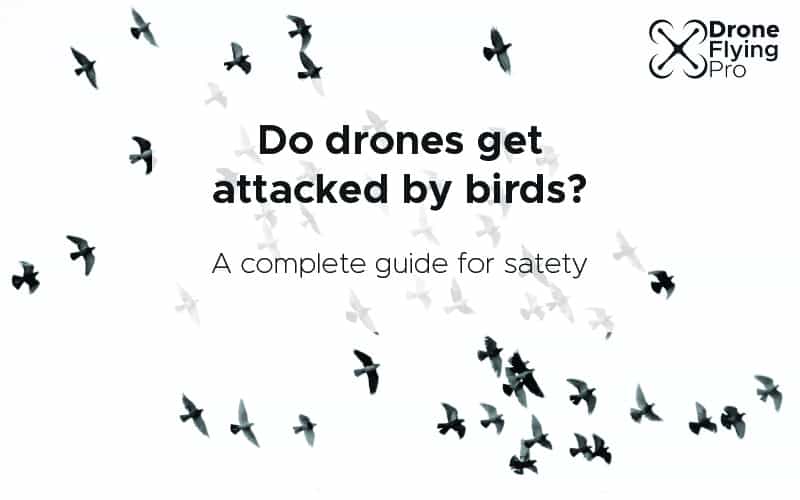
Here are some things to avoid while you are flying near cliffs with a lot of wildlife nearby.
Disrupting nests
If drones are flown too close to bird nesting sites the noise and unfamiliar sight of a drone could drive birds away from their nests. In a worse case result this could lead to the complete abandonment of eggs, or neglect of the egg to the point that it could become unviable.
Interrupting feeding
If you fly near a bird foraging or hunting for food the bird may go looking elsewhere for food sources. You could be forcing the bird to look for different, less abundant and nutritious food sources. Birds that cannot look after themselves are less likely to successfully breed and/or raise healthy chicks.
Striking
Flying your drone near nests of large birds of prey may illicit an attack. That is because your drone will be perceived as a threat to the nest and the birds’ eggs. Every time a bird is diverted away from its nest to attack or look at a drone it is no longer attending to the needs of its chicks and eggs.
Interrupting mating
The presence of a drone in a mating spot may cause the birds to abandon their mating efforts. The less bird sex going on the less likely the population will breed and continue to thrive.
There are many places that are protected from drones due to their potential impact on the wildlife in the area. Please take a moment to look at the laws in your country and specifically if you would likely be disturbing any birds nesting, mating, or foraging spots. Even if your proposed flying spot is not protected by legislation, please look at the area and abort your planned flight if you are attracting a load of bird attention or notice a large movement of birds after you take off.
Home point error
Drones have a number of different failsafes and return to home upon loss of signal is one of the most useful and welcome. I have never had to use an automatic return to home for my drone out of necessity but I’m confident that when it is needed it’ll be there. Sometimes I often allow the drone to return to home on its own so that I retain my confidence in the drone’s ability to land safely.
The home point that is recorded by the GPS unit of the drone upon takeoff has a certain error which fairies for each type of drone and GPS capability.
I highly recommend that you set your home point well away from the edge of the cliff as the drone may inadvertently miss the landing spot and fly too close to the edge of the cliff.
I recommend that you set your drone back at least 10 m away from the edge of the cliff which will enable you to hover initially without any fear of updraughts and also allow a huge margin of error for the event that your drone will need to return to home on its own.
Using a high contrast landing pad will also help the drone and land accurately as a number of the drones use a downward facing camera to execute precision landings.
Reduced signal strength
there is the potential for your drone to have a reduced signal strength as it disappears over the edge of the cliff. If you maintain a constant line of sight between the remote control and the drone this shouldn’t be an issue for you.
However, if you descend over the edge of the cliff and you lose line of sight with your drone there is a potential that your drone will lose signal with the controller.
This is because the drone connection between the remote and the drone is likely a Wi-Fi connection which requires a direct line of sight for maximum strength. Recent drones in the DJI system use the DJI OcuSync 2.0 method which has a maximum range of 10 km – using a drone with this technology will allow for a much greater signal stability.
If your drone goes out of range or it loses contact with the remote controller, do not worry, there are plenty of times that people have lost contact with their drone or it has got out of range. To find out exactly what happens if your drone goes out of range check out my other article – click here.
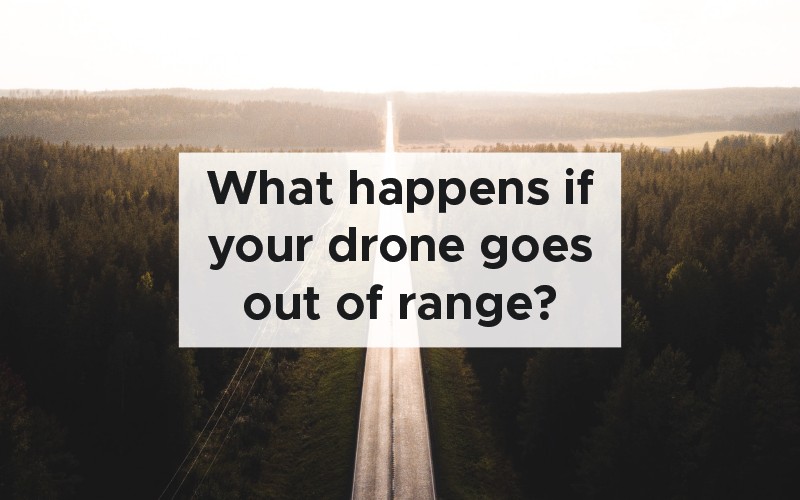
High elevations limit battery life
Drone battery life is also drained significantly faster at higher elevations. In this article, we have covered what is like to fly over a cliff which is close to ground level stop however, if you are flying in the mountains you have to be particularly careful that you keep track of your batteries depletion rate and that you have enough battery to return to home safely.
If the cliff is part of a mountain range there are a load of other safety requirements which will ensure that your drone returns to its home base without issue.
Stay away from the edge!
We all get a little bit carried away when we are flying our drone. I, personally, tend to sit still and stay in one spot. This ensures that my focus is entirely on the drone flight and I’m not worrying about anything else in my immediate environment.
However, I have seen that there are a few pilots that like to wander around while they are flying and try to keep the remote control pointed at the drone whilst walking slowly. If you are near the edge of the cliff you run the risk of getting too close to the edge.
Particularly if you are wearing a drone headset to view the first person view footage, you could end up becoming too engrossed with the flying and simply lose situational awareness causing you to come to personal harm.
Choose a comfortable and safe spot from which to pilot your drone and don’t be tempted to get closer to the edge if your drone is disappearing behind the ledge. Instead, fly the drone in line of sight out over the edge of the cliff so that it stays in direct contact with the remote control.
Best shots for flying off a cliff
Some of the best shots for flying over a cliff include getting a respective on the change in depth that you cannot get using any other form of photography or videography. In this section, we are going to go over some of the best shots that you can get around cliffs and how to do it safely.
Straight down
when I am flying near the edge of a cliff one of the first shots I take is looking straight down and flying over the edge. The sense of vertigo that this shot induces I think is very poignant.
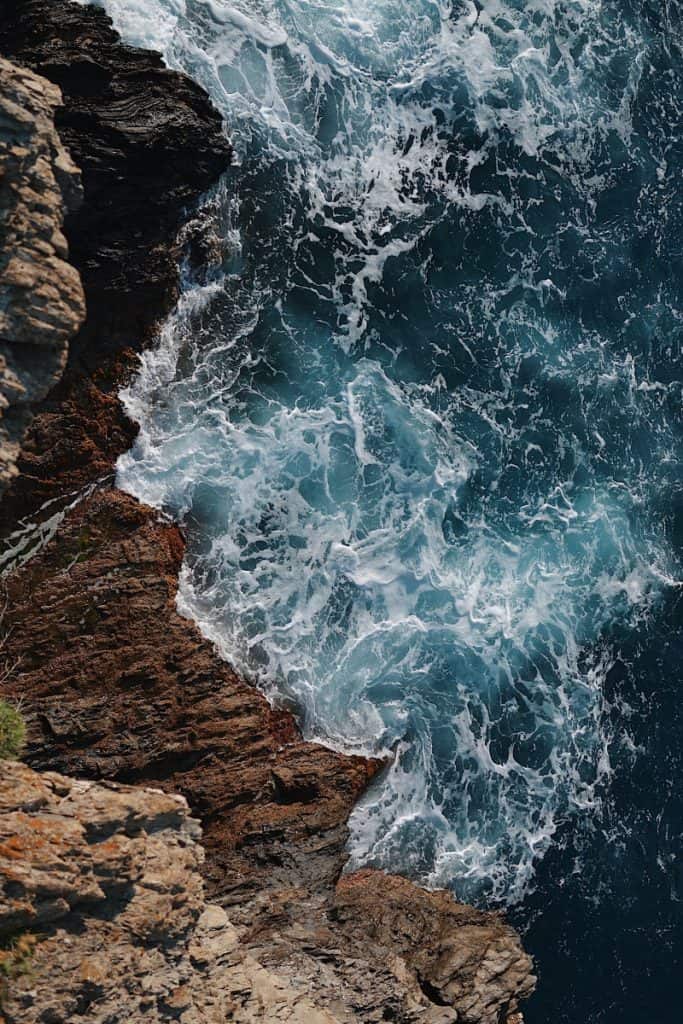
I particularly like flying relatively close to the ground before heading off out over the ledge of the cliff as this provides the maximum amount of contrast between close-up and faraway. The drones lenses do not typically have a short focal length and it requires you to fly little bit closer to the ground upon takeoff to achieve a good contrast between the depths.
Another reason I particularly like this shot is because there is a very high contrast between the riskiness of the cliff and the water that is lapping at the base.
Looking back at the cliff
once I have flown over the cliff looking straight back I like to do a dronie shot looking back at the cliff and flying out over the water. This enables me to get a sense of perspective of the entire cliff face and I continue reversing the drone until I can get the top of the cliff and the rocks and ocean at the bottom in full frame.
This is particularly useful if you are putting together some the role footage and I find that increasing the speed of the middle portion of the dronie results in a particularly impressive shot.
Contrast shot
During my entire flight I’m always looking for the best amount of contrast in the footage. There is something magical about recording at the edge of a cliff face and I think it is due to the ruggedness of the rocks and the softness of the water lapping at the foot of the cliffs.
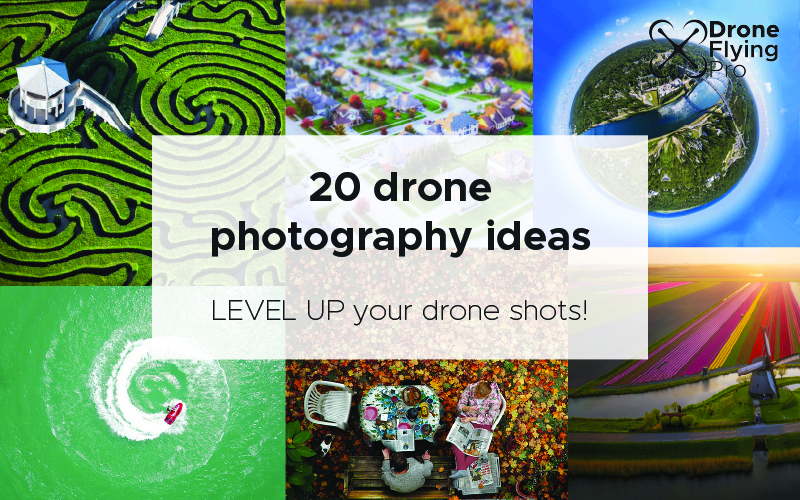
Summary
In this article, we have gone over exactly what happens when you fly a drone act over a cliff. Ultimately, nothing happens to your drone other than it being able to maintain its altitude despite the rapid change in topography underneath the drone of flying out over the ledge.
This does not mean that flying out over a cliff does not come with some risk and we have gone over all of the different risks which pose a threat to your drone including weather, wildlife, updraughts, home point error, and the cliff face itself.
Make sure that you know exactly what the weather situation is going to be for your flight and you will have a safe one. Flying out over a cliff is one of my favourite things to do and I’m sure you will enjoy it too!
